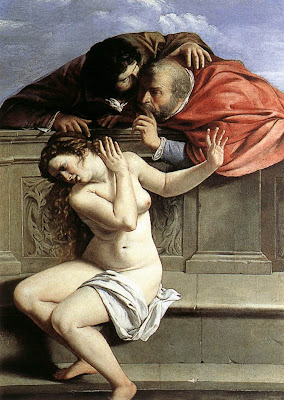Image: Susanna and the Elders (1610) by Artemisia Gentileschi Artemisia Gentileschi, oil on canvas, 170 x 121 cm, Schloss Weissenstein, Pommersfelden
In an era when women painters were not easily accepted by the artistic community, Artemisia Gentileschi (1593-1656), an Italian Early Baroque painter, was the first female painter to become a member of the Accademia di Arte del Disegno in Florence. She was one of the first female artists to paint historical and religious paintings, at a time when such themes were considered beyond a woman's reach.
The painting is about Susanna (or Shoshana), a fair Hebrew wife who bathes in her garden, having sent her attendants away. Two lustful elders secretly watch her and when she makes her way back home, they accost her, threatening to claim that she was meeting a young man in the garden unless she agrees to have sex with them. Susanna refuses to be blackmailed, and is arrested and she was about to be put to death for promiscuity when a young man, Daniel, interrupts the proceedings, yelling that he didn't want to be responsible of an innocent's death. Upon this, the two elder men are cross-examined of what they saw. The elders disagree about the tree under which Susanna supposedly met her lover. The first elder says they were under a mastic tree, and Daniel says that an angel stands ready to cut him in two. The second elder says they were under an evergreen oak tree, and Daniel says that an angel stands ready to saw him in two. The vast difference in the size between a mastic tree and an oak makes the elders' lie plain to all the observers. The false accusers are put to death and virtue triumphs.

No comments:
Post a Comment